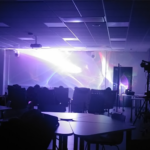
Ulla-Maija Knuutti, Mervi Friman & Satu Määttänen
In today’s information society, data and information have become the most valuable global resources. To utilize these resources to the fullest, they need to be managed, applied and shared effectively. Collaboration has proved as an effective method for this. Collaboration can take multiple forms and occur at various levels, but what is common to all collaboration schemes is that individuals or institutions pool their resources to work together for a defined target(s) (Di Vincenzo & Mascia, 2012; Rybnicek & Königsgruber, 2019). Collaboration not only provides access to information and other (im)material resources, but through exposure to different perspectives and practices, it also enhances knowledge creation, usage and maintenance, whether in a team, on an organizational or a societal level (Ankrah & AL-Tabbaa, 2015; Di Vincenzo & Mascia, 2012). These beneficial outputs of collaboration give rise to innovation, technological development and solving local and global challenges (Di Vincenzo & Mascia, 2012).
Within the complex and fast-paced world and working environments, collaboration within and among different institutions and individuals has become essential. For higher education institutions (HEIs) and the whole academic world, collaboration is an important tool to fulfill their main functions of (1) building human capital through competence development, (2) creating and applying new information and innovations through research and technology, and (3) contributing to social development and of solving pressing challenges (Watson et al., 2011, pp. 11, 15). Indeed, many institutional, national and global strategies urge for increased academic collaboration and networking (e.g. HAMK, 2019; Ministry of Education and Culture, 2016; United Nations, 2015). Collaboration, however, does not spring up and operationalize by itself, but it requires constant management and nurturing.
In this article, we reflect on experiences and perceptions of social factors in academic collaboration, within project settings, and between project participants. Social factors in this article refer to the relations and interactions between individuals and among individuals and institutions. According to the socio-constructivist theory, interaction and collaboration are the basis of knowledge creation (Vygotsky, 1978). Social factors can, depending on their form and manifestation, either strengthen or weaken collaboration and knowledge creation (Hodgkinson-Williams et al., 2008). The article focuses on two academic projects: national and international, due to authors’ interest in understanding the similarities and differences between these two contexts. Based on the findings presented in the article, we provide suggestions on how to build and nurture fruitful collaboration in academic projects, whether in national or international settings.
Material and methods
The article explores selected project participants’ perceptions and experiences of collaboration schemes in two academic projects.
The Circular Economy Excellence for Finnish Universities of Applied Sciences (CEEF) project (Jamk, n.d.) brought together 19 Finnish universities of applied sciences during 2018-2020. The project promoted circular economy in education by producing teaching materials and testing pedagogic methods.
AgriSCALE is a cross-continent project, running between 2020-2023, with nine partner universities from Europe and Sub-Saharan Africa. The goal of the project is to reform agricultural curricula to meet the requirements of the world of work, improve entrepreneurship education, and develop students’ skills in problem-solving and in climate-smart agriculture through problem-based learning. (AgriSCALE, n.d.)
We chose these projects as they are recent, and as the affiliated institution of the authors has been strongly involved in them.
To investigate general perceptions of collaboration, and how collaboration occurswithin and between institutions and individuals, a survey and interviews were conducted with CEEF project participants.
A structured online survey, with open and closed-ended questions, was sent to 34 purposefully selected CEEF project and work package leaders and other personnel with a major role in the project. During February and March 2021, a total of 12 project personnel participated in the survey. The survey consisted of questions focusing on dimensions of trust, responsibility, and practical arrangements. Questions within the framework of social capital were asked by twenty variables. In addition, three project staff members were interviewed (a manager, an assistant, and a teacher) to get more in-depth insights into the experience of collaboration. The interview questions were built on the survey questions, utilizing the same themes. Both the survey and interview questionnaire utilized the social capital frame by Padilla-Rivera et al. (2020).
The findings from the CEEF project are further enriched with two Finnish project personnel’s – authors of this article – experiences and reflections on the AgriSCALE project to bring in perspectives of international collaboration. Examination of collaboration in national and international settings can help to develop collaboration schemes in variable contexts and situations.
Findings: Perceptions of collaboration
We present the research findings through the lenses of social capital, social cohesion and social inclusion (Mulunga & Yazdanifard, 2014).
Social capital, whichin this context is understood as the networks, and assets and benefits gained from the networks (Burt, 2000; Mulunga & Yazdanifard, 2014). Networking and interactionwere depicted by the survey participants as encounters with new colleagues from different institutions, and in some cases within their own institution. Networks and collaboration are strongly interlinked. Collaboration occurs within and through networks (García-Martínez et al., 2022), and thus, networks can be considered as precedes and enables of collaboration. On the other hand, collaboration, in turn, can widen the networks. The creation and maintenance of a network require facilities and effort.
Collaboration is associated with improved learning (Laal & Ghodsi, 2012), and within the survey responses learning with and from each other was mentioned several times. According to the respondents, working on the collaborative project has increased participants’ personal knowledge and through this also institutions´ know-how. Within an international setting, as in the cross-continental AgriSCALE project, interaction and networking among participants have been challenging due to the physical distance and different time zones. The COVID-19 pandemic posed further challenges, as at the beginning all interactions needed to be organized online. To enhance collaboration among participants, the project has arranged activities like small online group discussions, where people have met each other and have had the opportunity to discuss their focus of interest with people coming from different universities and countries. In-person meetings and interactions later in the project, cycle have made a stark difference. Contacting and communicating with partners has felt easier having met them at least once.
Social cohesion, referring to strong relationships between individuals (Di Vincenzo & Mascia, 2012), realize in practice as a safe space for questioning and self-expression. In the survey and interviews, social cohesion was mentioned as an element that increases helpfulness among partners and individuals. To create social cohesion and dialogical collaboration, listening and understanding other individuals were perceived as important. The majority (66%) of the survey participants had observed competitive behavior at least occasionally. The data is not enough for in-depth analyses, but the results indicate that those who observed competitive behavior also observed fewer equal opportunities, more discrimination, and less social cohesion and inclusion.
Social inclusion within collaborationwas perceived to enable everyone to bring in their competences and ideas. Research participants reported acceptance of different opinions and individuals, as well as tolerance towards conflicts and contradictions as key pillars of social inclusion. Obtaining social inclusion requires more effort in cross-continent collaboration, where participants come from various cultures, hierarchical systems, and educational and other backgrounds and may have unequal access to various resources. Corruption is related to social inclusion, with corruption reducing social inclusion while on the other hand enabling social inclusion can reduce corruption (Warren, 2004). Of the survey participants, no one had observed corruption. Corruption erodes trust, which has a negative influence on collaboration. According to The Fund for Peace (2022), culturally and traditionally Finland and many African countries represent different attitudes towards corruption which presumably exist also in collaborative operations.
Guidelines for fruitful collaboration
Utilizing the survey and interview findings, and our own experiences, we propose steps to promote fruitful academic collaboration. We believe that despite national, cultural, and traditional divergencies they can be applied in collaboration schemes to increase social capital, cohesion, and inclusion.
The preconditions for a successful collaboration are commitment and adequate time resources to get to know each other, and especially the key project personnel. Mutual understanding and agreement on the project objectives, as well as a clear division of labor and roles are crucial for enabling fruitful teamwork. Collaborative projects should be built to foster an environment that encourages and rewards helping others. During a project, and especially at the end of it, constructive feedback should be given and shared, and everyone’s contributions acknowledged and commended.
Leadership is a valuable tool for creating and maintaining social inclusion and equality. Leaders should make sure that sharing, co-creation, and transparency are enabled and achieved. All the collaborative partners should be given the opportunity to make an impact, and guidelines set to avoid discrimination of any kind. Neutral mechanisms for influencing and communication should be put in place.
Confidence is an essential element of collaboration. Goals and practices should be agreed upon together and transparently. Everyone should feel free to share their knowledge and skills without the fear of being exploited or someone else taking credit. Competition reduces social cohesion and capital, and among them confidence and knowledge creation and sharing. Thus, it should be avoided at all costs. Competition can occur not only among individuals but also among collaborating institutions.
Personal development and learning are strong motivators for collaborative project personnel. Through the individual and shared learning processes of the project participants, the institution will benefit from the new knowledge and networks. Institutions should have structures set up for institutionalizing the knowledge and skills created.
Conclusions
Collaboration is an efficient tool to create and manage information, and subsequently contribute to innovation, technological development and solving local and global challenges. Yet, nurturing collaboration requires effort, consideration, and team spirit from the management staff, as well as from individual project workers. According to the survey, participants appreciated collaboration and saw it as a means for individual and institutional development. Collaborators of academic projects acknowledged the importance and benefits of social capital and collaborative learning and recognized social cohesion and inclusion as important determinants of collaboration.
To enable and maintain successful collaboration schemes, enough time and resources need to be allocated to networking and interactions, and sufficient and transparent management structures put in place. To utilize and institutionalize the benefits of collaboration requires the set up of institutional structures. The guidelines provided in this article can help in setting up and managing academic collaboration schemes. However, for further development of collaborative projects and collaboration management, research and information on cultural sensitivity and other ethical issues within collaborative projects would be needed.
Authors
Ulla-Maija Knuutti, M.Sc. In Rural Development from Häme University of Applied Sciences. She works as a Senior Lecturer in HAMK Edu Research Unit.
Mervi Friman, Ph.D. (Educ.), has worked in administration and research duties at Häme University of Applied Sciences (HAMK) for over 30 years.
Satu Määttänen, M.Sc. in Agricultural Sciences and M.Sc. in Environmental Science and Policy from the University of Helsinki. She works as a Research Assistant at Häme University of Applied Sciences in Bio Research Unit.
References
AgriSCALE. (n.d.). AgriSCALE. https://www.agriscale.net/
Ankrah, S., & AL-Tabbaa, O. (2015). Universities-industry collaboration: A systematic review. Scandinavian Journal of Management, 31(3), 387–408. https://doi.org/10.1016/j.scaman.2015.02.003
Burt, R. S. (2000). The Network Structure Of Social Capital. Research in Organizational Behavior, 22, 345–423. https://doi.org/10.1016/S0191-3085(00)22009-1
Di Vincenzo, F., & Mascia, D. (2012). Social capital in project-based organizations: Its role, structure, and impact on project performance. International Journal of Project Management, 30(1), 5–14. https://doi.org/10.1016/J.IJPROMAN.2011.03.006
García-Martínez, I., Tadeu, P., Montenegro-Rueda, M., & Fernández-Batanero, J. M. (2022). Networking for online teacher collaboration. Interactive Learning Environments, 30(9), 1736–1750. https://doi.org/10.1080/10494820.2020.1764057
HAMK. (2019). HAMK 2030: Vision and Strategy. https://www.hamk.fi/wp-content/uploads/2019/02/HAMK_strategy2030.pdf
Hodgkinson-Williams, C., Slay, H., & Siebörger, I. (2008). Developing communities of practice within and outside higher education institutions. British Journal of Educational Technology, 39(3), 433–442. https://doi.org/10.1111/J.1467-8535.2008.00841.X
Jamk. (n.d.). CircularEconomyUAS. https://www.jamk.fi/en/project/circulareconomyuas
Laal, M., & Ghodsi, S. M. (2012). Benefits of collaborative learning. Procedia – Social and Behavioral Sciences, 31, 486–490. https://doi.org/10.1016/J.SBSPRO.2011.12.091
Ministry of Education and Culture, F. (2016). Better Together for a Better World. Policies to Promote Internationalisation in Finnish HigherEducation and Research 2017 – 2025. https://julkaisut.valtioneuvosto.fi/bitstream/handle/10024/79438/Better%20Together%20for%20Better%20World%20-%20Leaflet%202018.pdf
Mulunga, S. N., & Yazdanifard, R. (2014). Review of Social Inclusion, Social Cohesion and Social Capital in Modern Organization. Global Journal of Management and Business Research: Administration and Management, 14(3). https://journalofbusiness.org/index.php/GJMBR/article/view/1253
Padilla-Rivera, A., Russo-Garrido, S., & Merveille, N. (2020). Addressing the Social Aspects of a Circular Economy: A Systematic Literature Review. Sustainability, 12(19), 7912. https://doi.org/10.3390/SU12197912
Rybnicek, R., & Königsgruber, R. (2019). What makes industry–university collaboration succeed? A systematic review of the literature. Journal of Business Economics, 89(2), 221–250. https://doi.org/10.1007/S11573-018-0916-6
The Fund for Peace. (2022). State Resilience Index. Annual Report. http://fundforpeace.org/wp-content/uploads/2022/12/SRI-Index-12.6.22-II80.pdf
United Nations. (2015). Transforming Our World: The 2030 Agenda For Sustainable Development. https://sdgs.un.org/publications/transforming-our-world-2030-agenda-sustainable-development-17981
Vygotsky, L. (1978). Mind in Society: The Development of Higher Psychological Processes. Harvard University Press.
Warren, M. E. (2004). What Does Corruption Mean in a Democracy? American Journal of Political Science, 48(2), 328–343. https://doi.org/10.1111/J.0092-5853.2004.00073.X
Watson, D., Hollister, R., Stroud, S., & Babcok, E. (2011). The engaged university : international perspectives on civic engagement (1st ed.). Routledge.





